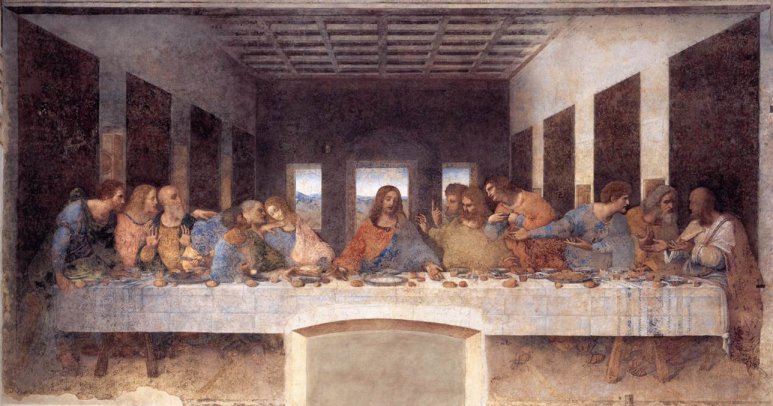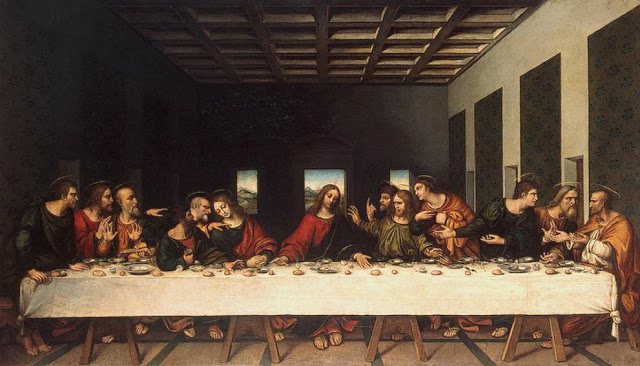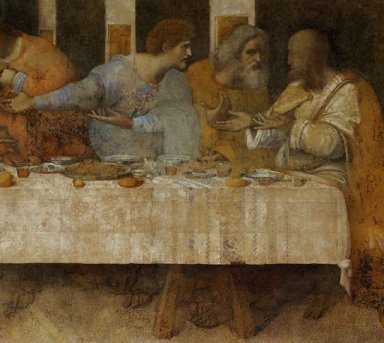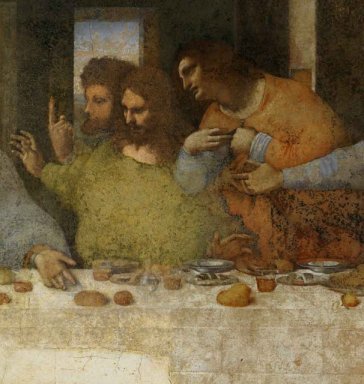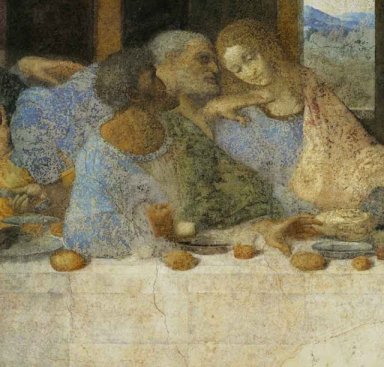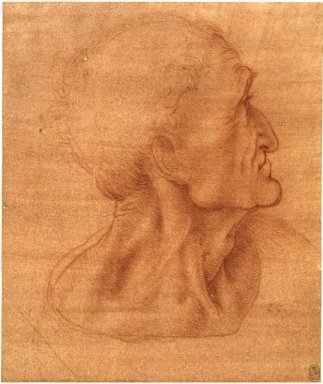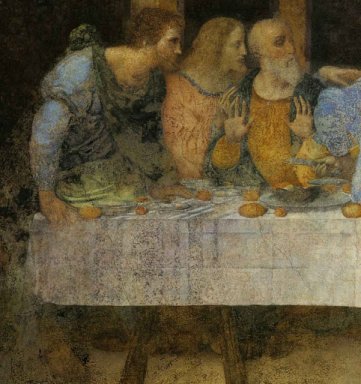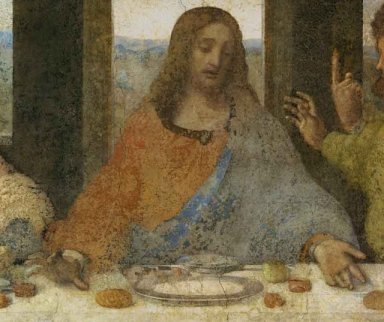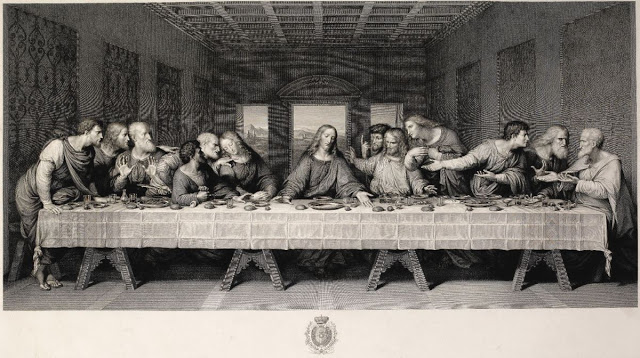|
Leo
Steinberg: Leonardo’s Incessant Last Supper
|
|
The damage to Leonardo da
Vinci’s famous Last Supper is well known. Even after the most recent
restoration the huge fresco that measures over 29 by 15 feet is in such
perilous condition that viewing access is strictly controlled and
limited. We know from early copies
that much of Leonardo’s work has been irretrievably lost or covered.
Early on the feet of Christ and the Apostles had so disappeared that the
monks had no reluctance to put a door in the wall under the figure of
Christ. We know of this from copies but even the earliest copies are
often unreliable and omit or alter certain important details. Finally,
although the painting is still in its original venue, it is impossible
to replicate the monk’s dining room and see the painting as its
original viewers would have seen it. |
|
|
|
Compared
to the physical damage that Leonardo’s work has suffered, the
interpretive damage has been even greater. It was this damage that Leo
Steinberg set out to repair first in an extended essay, Leonardo’s
Last Supper, that appeared in the Art Quarterly in 1973. In 2001,
Steinberg returned to this work, revising it for publication in his
book, Leonardo’s Incessant Last Supper. In the introduction to his
book Steinberg recalled two questions that he had raised in the 1973
study. “Is there anything left to see? And, Is there anything left to
say?” Of course his answer was positive: 'What
remains to be told about Leonardo’s Last Supper is not some residual
matter previously overlooked; the novelty of the subject is the whole of
the work responding to different questions. In the present study, the
picture emerges as both less secular and less simple; contrary to
inherited notions, it is nowhere “unambiguous and clear,” but
consistently layered, double functioning, polysemantic.' Steinberg took on an academic
tradition that had been entrenched ever since the time of the
Enlightenment, especially after Goethe’s famous essay claimed that
Leonardo had depicted the psychological shock on the faces of the
Apostles at the moment immediately following the announcement of the
betrayal. Goethe’s interpretation had seemingly settled the matter for
all future observers. Steinberg, however, blamed nineteenth century
secularism for a profound mis-reading. 'In the
art of the Renaissance, the obscurantism imputed to religious
preoccupations seemed happily superseded. Ideal art was believed to
reveal humane truths which the service of religion could only divert and
distort. And it was again in Leonardo in whom these highest artistic
goals, originally embodied in ancient Greece, seemed reaffirmed. In this
projection of nineteenth-century values upon Renaissance art, the
masterworks of the Renaissance were reduced to intelligible simplicity,
and Leonardo’s Last Supper became (nothing but) a behavioural study of
twelve individuals responding to psychic shock.' Moreover, I suspect that
today, one year after Steinberg’s death at the age of 90, his thesis
is still only known by a small coterie of art historians. Reading
Steinberg’s Incessant Last Supper not only brings one deeper into a
great masterpiece, but also deeper into the mind and culture of the
genius who was Leonardo. However, since the common view holds that the
painting depicts the psychological reaction to the announcement of the
betrayal, I would like to concentrate on Steinberg’s analysis of
Leonardo’s portrayal of the Apostles. '...never
before attempted, was to collect in “conjoint presence” a superdozen
male sitters strung across nearly 29 feet of wall, to convert the drag
of enumeration into what he called a “harmonic total effect." ' |
|
|
| Much of the detail of the original has been lost but an anonymous copy c.1550 gives a very good look at the hands and feet of the thirteen men in the picture. Steinberg’s stresses the significance not only of the feet of Christ but of the Apostles. Christ’s feet are central and larger and they announce his impending crucifixion. The feet of the Apostles are there to be washed but also represent their role and future destiny, "This very night, each of these feet is washed and wiped dry by the Master. In view of the gospel…how negligible can these feet be; surely, this is their hour!" |
|
|
| Starting with the three on our right at the end of the table, the six open hands in gesture toward Christ, seemingly in response to the word “take!”. Steinberg proposes the Eucharistic interpretation, indicating that Communion of the Apostles is imminent. Hands take on special significance. Steinberg takes special note of the “affinity” of the left hand of Thaddeus to the left hand of Christ, "Thaddeus’ hand toward Christ; Christ’s toward us. It is missing a lot to dismiss the correspondence as accidental." |
|
|
| Feet, hands, even fingers are important. In the triad at Christ’s left hand (Philip, Thomas, James). The upright finger of Thomas, who has thrust himself forward toward Jesus, is particularly noted for its repeated use by Leonardo, "...this upright finger occurs in Leonardo’s rare paintings no less than four times, invariably pointing to heaven… The steeple finger is Leonardo’s trusted sign of transcendence." |
|
|
|
'The inner
triad refers to imminent Crucifixion. It contains the dark force that
sets the Passion in motion, then, behind Judas, St. Peter. Peter’s
right hand points the knife he will ply a few hours hence at the arrest.
And the interlocking hands of the beloved disciple are pre-positioned
for their grieving on Calvary.' The figure of Judas who
recoils from the plate is given special attention. Steinberg’s
interpretation is buttressed by an analysis of a Leonardo drawing: 'Leonardo’s initial rendering of the betrayer tracks inner conflict; lips clenched under enchanted eyes that gaze on their gift of light,…the wretchedness of a man who had once been chosen by Jesus…but whose nature, having experienced devotion, retains its capacity for remorse…Leonardo brought a tragic vision far in advance of what his contemporaries could fathom. The subjective experience of abjection never received more humane understanding.' |
|
|
|
|
|
'For
those who have seen a priest at the altar, who recall the corresponding
pose of St. Francis stigmatized and, finally, Andrew’s own story, he
is the Apostle whose lodestar is crucifixion… ' The last Apostle is
Bartholomew who “stands exposed to the knife levelled at him by
Peter’s right hand….an oddly apt accident or else staged with
intent.” According to tradition Bartholomew was skinned alive, but
another tradition had him crucified, a martyrdom he yearned for in order
to emulate the Master. Crucifixion, according to Steinberg, explains the
odd crossing of Bartholomew’s feet, an otherwise inexplicable oddity
that even led some copiers to correct Leonardo’s “mistake.” Finally, no review can do justice to Steinberg’s discussion of the figure of Christ, no longer seen as a passive figure sitting back while the Apostles react to the betrayal announcement. |
|
|
|
For Steinberg, the institution of the Eucharist is central to the
painting: 'As the
person of Christ unites man and God, so his right hand summons the agent
of his human death even as it offers the means of salvation. The Christ
figure as agent—both hands actively molding his speech, and both
directed at bread and wine…Christ becomes the capstone of a great
central pyramid…And midway between the…slopes of Christ arms and the
floor lines that transmit their momentum, exactly halfway, there lies
the bread, and there lies the wine.' It should be clarified here, Goethe's widely quoted interpretation of the Last Supper omits this point, as he had only seen the painting briefly in Milan. Hence, his analysis primarily relied on a copy that left out the bread and wine of the Eucharist. (nb. see notes under Antoniewicz) |
|
|
|
The above discussion primarily relates to the analysis presented in the
third and fourth chapters of Leonardo's Incessant Last Supper. Steinberg
goes on to show how the painting must be understood in terms of the
whole room in which it was viewed, and even in terms of the whole
complex of which S. Maria della Grazie was a part. This final quotation
gives a good summary. 'I think
we see—or would have seen had the mural survived intact—a willed
visual metaphor. Within the geometry of the picture, the elements of the
Eucharist, placed in extension of Christ’s earthly presence, serve as
conveyors: from the centrality of the Incarnate toward the faithful this
side of the picture.' Steinberg backed up his
interpretation with a virtuoso display of all the tools available to a
modern art historian. He displayed a magisterial familiarity with the
interpretive history; the texts; the traditional legends; the related
paintings; and with the entire body of Leonardo's work. More than
anything else, however, was his ability to convey the culture of
devotion in Medieval and Renaissance Christianity. Sources
|
| Dr. Francis P. DeStefano is a retired assistant professor of history, who now dedicates his time to writing and lecturing independently on history and art history. His key area of interest is Venetian Renaissance art, particularly the works of Giorgione. His ongoing research into historical and sacred themes influencing artists in the Renaissance can be read at Giorgione et al, and its parent site MyGiorgione. |
